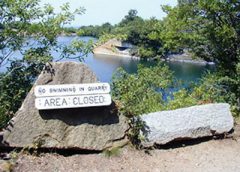By Mark S. Kuhar
If you do a Google search on “Quarry” this time of year, you will invariably come up with a great many articles about people who have died swimming in an active or abandoned quarry. Consequently, the U.S. Department of Labor’s Mine Safety and Health Administration (MSHA) created “Stay Out! Stay Alive!” – a public safety campaign to educate children and adults about the existing hazards at a mine site.
The campaign is a partnership made up of nearly 70 federal and state agencies, private organizations, businesses and individuals. These groups visit schools and communities nationwide to distribute educational materials and discuss the importance of mining and its existing hazards.
Mines are located in every state, from small sand and gravel operations to complex underground coal, salt, limestone or metal mines, to extensive surface operations. There are about 14,000 active and as many as 500,000 abandoned mines in the nation. As cities and towns spread into the surrounding countryside and more people visit remote locations, the possibility of contact with an active or abandoned mine increases.
While the men and women employed in our nation’s mines are trained to work in a safe manner, for the unauthorized explorer, hiker, off-roader or rockhound, the hazards are not always apparent.
Active and abandoned mine sites have proved to be an irresistible and sometimes a deadly draw for children and adults. MSHA tells the public this:
- Vertical shafts can be hundreds of feet deep. At the surface, they may be completely unprotected, hidden by vegetation or covered by rotting boards.
- Horizontal openings may seem sturdy, but rotting timbers and unstable rock formations make cave-ins a real danger. Darkness and debris add to the hazards.
- Lethal concentrations of deadly gases (methane, carbon monoxide, carbon dioxide and hydrogen sulfide) can accumulate in underground passages.
- Unused or misfired explosives can become unstable and deadly vibrations from a touch or footfall can trigger an explosion.
- Excavated vertical cliffs (highwalls) in open pit mines and quarries can be unstable and prone to collapse.
- Hills of loose material in stockpiles or refuse heaps can easily collapse upon an unsuspecting biker or climber.
- Water-filled quarries and pits hide rock ledges, old machinery and other hazards. The water can be deceptively deep and dangerously cold. Steep, slippery walls make exiting these swimming holes extremely difficult.
Any community with active or abandoned mines, quarries or pits – such as yours – could become the scene of the next tragedy. For more information on “Stay Out! Stay Alive!” or how to become a partner in this campaign, contact the Mine Safety and Health Administration at 202-693-9400.

